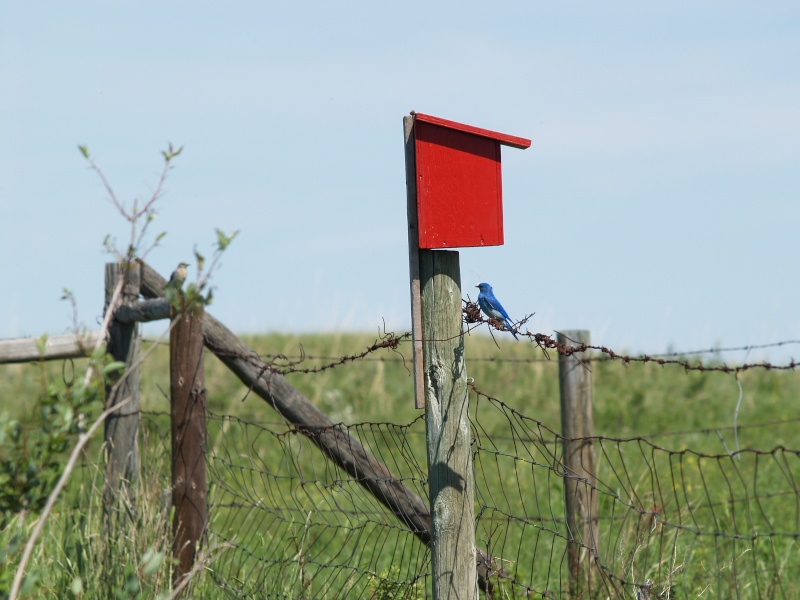An ideal nest box for bluebirds would have a floor 20 cm square, walls 25 cm high, with a 3.8 cm diameter entrance hole located 18 cm above the floor.
The top of the birdhouse should be easily opened for cleaning. It should overhang the entrance hole to provide protection from rain.
Two 6-mm holes should be drilled near the top of each side for ventilation and two 6-mm holes should be made in the floor for drainage.
Perches should not be placed on the birdhouse, as they only encourage House Sparrows to take up residence.
If an exterior finish is desired to preserve the wood, a woodstain is adequate. If houses are painted, a light green, brown, or grey should be used. White is too conspicuous, and a white nest box is often shunned by bluebirds. Dark colors absorb heat, which may become too intense for the eggs or young in the nest box. Do not paint or varnish the inside of the box. The interior walls should have a rough surface to aid the bird in climbing up to the entrance hole.
This makes sense in terms of what I have seen them doing, the boy picks the house!
The males often arrive first, and waste little time in searching out suitable nesting sites: woodpecker excavations and decayed cavities in trees are used where available. In the treeless badlands, bluebirds nest in cracks and crevices of steep eroding hillsides. In built-up areas, they move into machinery, nooks and crannies in buildings, fence-posts, and utility poles. Recently, the birdhouse has become an important nesting site.
Once the male has found cavities to his liking, he entices a prospective mate to inspect them. The male goes in and out of each cavity, fluttering excitedly about the female and calling continually, all in an effort to have her accept the site. This exuberant display may last, off and on, for hours or even days, until a female finally condescends to try out the cavity for size. She decides whether to accept or reject the site.
After a nest site is agreed upon, both birds defend the immediate area. The female builds the nest of dry grass stems and finer plant material, including thin strips of soft bark, while the male oversees her activities and guards against intruders. This process may take anywhere from two days to more than a week.
Soon after completing the nest, the female lays one egg each day until the clutch, usually with five or six eggs, is complete. Occasionally there are up to eight eggs in a clutch.
Incubation, or warming of the eggs until they hatch, starts after the final egg is laid and lasts for approximately 13 days. Only the female performs this task. She sits on the eggs all night and most of the day, leaving the nest briefly to feed. Occasionally, the male brings food to his mate.
After the eggs hatch, the blind, naked, and helpless fledglings must be fed. The female spends much of her time the first week brooding, or sitting on the young birds to keep them warm, and feeding them with food delivered by the male. On a diet of insects, including beetles, cutworms, and grasshoppers, the fledglings grow rapidly, doubling their body weight two or three times during the first week of life. The young birds’ droppings come encased in a sac that can be carried away by the adults, so the nest remains clean for the first week or two. At 14 days of age the tiny bodies are nearly completely feathered, and the young leave the nest at about 18 to 21 days, although the timing of fledging is quite variable. Bluebirds are able to fly about 100 m on their first rather haphazard flight.
The young are wholly dependent for about three days, and may not be fully independent until two months later. Approximately half of adult pairs prepare a nest for a second brood. This is usually built in the same cavity. The second clutch of eggs is about one egg smaller than the first. If the eggs or young of any brood are destroyed by predators, the bluebirds will avoid the nesting site for the rest of the season and may move as much as 200 km to establish a new nest site.
Groups of one or more families and other individuals remain in the area throughout the summer and autumn until cold weather drives them south for another winter.
So much for painting one of them white! And red, oh dear it is a dark color maybe will absorb too much heat for the little ones, perhaps mrs bluebird knows best and wont choose the red or white house?
I always look this stuff up after! oh well, we will let them decide....











